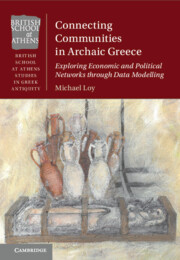 Connecting Communities in Archaic Greece
Connecting Communities in Archaic Greece Book contents
- Connecting Communities in Archaic Greece
- British School at Athens Studies in Greek Antiquity
- Connecting Communities in Archaic Greece
- Copyright page
- Contents
- Figures
- Tables
- Acknowledgements
- Abbreviations
- 1 Introduction
- 2 Economic Networks
- 3 Economic Networks
- 4 Entangled Networks
- 5 Political Networks
- 6 Political Networks
- 7 Conclusions
- Bibliography
- Index
1 - Introduction
Published online by Cambridge University Press: 13 July 2023
- Connecting Communities in Archaic Greece
- British School at Athens Studies in Greek Antiquity
- Connecting Communities in Archaic Greece
- Copyright page
- Contents
- Figures
- Tables
- Acknowledgements
- Abbreviations
- 1 Introduction
- 2 Economic Networks
- 3 Economic Networks
- 4 Entangled Networks
- 5 Political Networks
- 6 Political Networks
- 7 Conclusions
- Bibliography
- Index
Summary
This chapter begins by considering the pattern of archaeology in Greece form the past 100 years that has generated huge datasets – and that these datasets have been largely under deployed in making historical conclusions about Greece of the seventh and sixth centuries BC. After reviewing the history of scholarship on ‘Archaic Greece’ (and the relative quietness of scholarship on this topic in the most recent decades) this chapter considers ways in which the huge amount of data from Archaic Greece could be organised and analysed. Various methods from the Digital Humanities are considered, with discussion focusing also on data cleaning and organisation, before proposing that network analysis will be a useful framework for this study in making clear the ways in which the first communities of Archaic Greece formed economic and political alliances – and rivalries – with one another.
Information
- Type
- Chapter
- Information
- Connecting Communities in Archaic GreeceExploring Economic and Political Networks through Data Modelling, pp. 1 - 30Publisher: Cambridge University PressPrint publication year: 2023